Understanding the Function and Importance of Double Lip Shaft Seals in Mechanical Applications
Understanding Double Lip Shaft Seals A Comprehensive Overview
Double lip shaft seals play a crucial role in various mechanical systems, ensuring the longevity and efficiency of rotating equipment. Designed to prevent the ingress of contaminants and the egress of lubricants, these seals are essential in applications ranging from automotive engines to industrial machinery. This article delves into the structure, functionality, advantages, and applications of double lip shaft seals.
Structure of Double Lip Shaft Seals
A double lip shaft seal consists of two sealing lips made from elastomeric materials, which are typically reinforced with metal or fiber to enhance their durability. These two lips work in tandem to create a secure barrier against external elements. The inner lip is designed to seal against the rotating shaft, while the outer lip ensures a snug fit against the housing.
The materials used in manufacturing these seals are carefully selected based on the working environment. Common materials include nitrile rubber, fluoroelastomers, and polyacrylate, each offering unique properties suited for specific temperatures, pressures, and chemical exposures.
Functionality
The primary function of double lip shaft seals is to maintain a lubricant reservoir while preventing the ingress of dirt, dust, and moisture from the external environment. This is particularly important in applications where the equipment is exposed to harsh conditions. The dual sealing mechanism provides an added layer of protection, enhancing the seal’s effectiveness.
When the shaft rotates, the inner sealing lip presses against it, creating a tight seal that minimizes leakage. The outer lip, meanwhile, provides additional support, ensuring that the contact remains intact even under varying operational conditions. This dual configuration helps mitigate wear and tear, which can lead to costly repairs and downtime.
double lip shaft seal

Advantages of Double Lip Shaft Seals
One of the key advantages of double lip shaft seals is their enhanced sealing capabilities compared to single lip designs. The presence of two sealing lips improves resistance to leakage, making them ideal for high-speed applications where the risk of lubricant loss is significant. Moreover, double lip seals provide better protection against external contaminants, extending the life of both the seal and the machinery.
Another benefit is their versatility. Double lip shaft seals can be designed to accommodate different shaft sizes and configurations, making them suitable for a wide range of applications. They also perform well across varying temperatures and pressures, providing reliable operation in diverse environments.
Applications
Double lip shaft seals are utilized in various industries, including automotive, aerospace, manufacturing, and oil and gas. In automotive applications, they are often found in crankshafts, axles, and transmission systems, where they protect against oil leaks and contamination. In industrial machinery, these seals are critical in pumps, motors, and gearboxes, ensuring optimal performance and reducing maintenance costs.
In the aerospace industry, double lip seals are employed in engines and landing gear systems, where reliability is paramount due to the challenging operational conditions. The oil and gas sector also relies on these seals in drilling equipment and pipelines to safeguard against environmental hazards.
Conclusion
In conclusion, double lip shaft seals are integral components in numerous mechanical systems, providing reliable sealing solutions that enhance performance and durability. Their innovative design, combined with versatile applications across various industries, makes them essential for protecting machinery from wear and tear. As technology advances, the materials and designs of these seals continue to evolve, ensuring they meet the ever-growing demands of modern engineering challenges. Understanding the importance of double lip shaft seals can lead to better maintenance practices and improved machinery longevity, ultimately benefiting both manufacturers and end-users alike.
-
Understanding the Front Main Engine Seal: Purpose, Maintenance, and Installation
News Jul.29,2025
-
Understanding O-Rings and Seal Rings: Types, Applications, and Custom Solutions
News Jul.29,2025
-
Understanding Crankshaft Oil Seals: Rear Seals, Pulley Seals, and Their Role in Engine Integrity
News Jul.29,2025
-
The Importance of Front and Rear Crankshaft Seals in Engine Performance and Oil Management
News Jul.29,2025
-
Crank Oil Seals: Functions, Types, and Cost Considerations in Engine Maintenance
News Jul.29,2025
-
A Comprehensive Guide to O-Rings and Seals: Types, Materials, and Global Applications
News Jul.29,2025
-
Mastering Diesel and Performance Engine Maintenance: A Guide to Critical Oil Gaskets
News Jul.28,2025
Products categories















